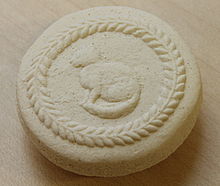Springerle
Springerle (in Switzerland Anisbrötli or Springerli - in Franconia eggs sugar is called) a traditional festive pastry from a Anis -Eierschaumteig. It was baked on church holidays (Easter, Whitsun and Christmas) as well as on family celebrations (weddings, baptisms) with suitable motifs. They belong as Spekulatius for Pastry. Springerle are known in southern Germany, parts of Austria, Switzerland, Alsace and Hungary. (Lorraine recipes for so-called "Pain d'anice" contain the same ingredients and preparation information, but no model is used anymore.) The name, the southern German diminutive of Springer, comes either from a popular motif, a rider (Springer) or, what is much more likely, from popping up when baking. When baking, the dough doubles in height and a "foot" forms at the bottom.
preparation
A dough is prepared from eggs , powdered sugar and flour, which is placed in the cold for a few hours before it is rolled out into a sheet of dough about 0.5–1 cm thick. In some recipes, a little staghorn salt is added as a leavening agent. On the rolled dough to model down to shape the motive cookies. The springerle are cut out, placed on a baking sheet greased with butter and sprinkled with aniseed and left to dry for about 12-24 hours before baking. During this time, the image will solidify and will not change any more during baking. The underside of the dough pieces must still be moist when baking so that the springerle does not burst open on the top and the motif is destroyed.
The springerle are baked in the oven at 130-140 ° C for about 30 minutes. Thanks to the heat of the oven, the dough pieces grow noticeably to around twice their height, thus forming so-called feet. The cookies only become soft after a long storage period of two to three weeks. Storage in a tin can is recommended until consumption.
Historical
When exactly the Springerle were invented is unknown. At least since the Middle Ages there have been models made of stone, metal, ceramic or wood to add pictures to pastries. The development of the church wafer bakery took its starting point . The first Springerle motifs were of church origin. Biblical stories or Christian symbols were depicted. Christmas and Easter motifs were very popular.
In the 17th and 18th centuries, more and more secular motifs prevailed. It started with heraldic motifs. The themes of happiness, love and fertility were strongly represented in the 17th to 19th centuries. Fashionably dressed women, magnificently decorated riders, love carriages, fertility and love symbols have been preserved in old models. According to the motifs, the Springerle were given away for engagement, wedding and as a promotional gift.
The model
The usual material for wooden models is pear wood . It's hard, hardly splinters and its hairs don't stand up when it gets wet. This also makes the finest chasings visible on the cookies. For a long time, model stitching was part of the craft of confectioners or confectioners. Models belong to folk art and are rarely signed. Today's models are mostly made with the help of milling machines or cast in synthetic wood.
Exhibitions
For a few years now, between November and the New Year, there has been an exhibition on the subject of Springerle in the Museum im Schlössle in Freiberg am Neckar . There is a Springerle Museum in the Lower Alsatian town of La Petite-Pierre (Lützelstein) . In the city of Strasburg, Pennsylvania (USA) there is a “Springerle House” (a small café) with a collection of models. In the Museum of Bread Culture, in the State Museum in Stuttgart in the Old Castle and in Waldenbuch in the Museum of Everyday Culture , there is a remarkable collection of models in the exhibitions and also in the museum shops.
literature
- Wooden model from Hohenlohe . ISBN 3-923740-06-9
- Linus Feller: Änismodel - history, customs, symbolism . Paradies-Verlag, Olten, 1998.
- Almute Grohmann: Baking with models . ISBN 978-3-00-033165-7
- Elke Knittel, Rolf Maurer: Springerles-Back-Lust , Silberburg-Verlag, Tübingen, ISBN 3-87407-627-X
- Elke Knittel, Rolf Maurer: Model treasures . Silberburg-Verlag, Stuttgart 2005, ISBN 3-87407-676-8 .
- Felicitas Hartmann: eye candy and culinary delights. On the change in value and use of Springerles models . (= Studies and materials of the Ludwig-Uhland-Institut of the University of Tübingen; Vol. 31). Tübingen Association for Folklore, Tübingen 2007, ISBN 3-932512-45-6
- Christa Fischer: Proud riders, beautiful ladies ... the world of images of the pastry model . Jan Thorbecke Verlag, Ulm 2012, ISBN 978-3-7995-0386-0 , 256 pages, over 700 color images






